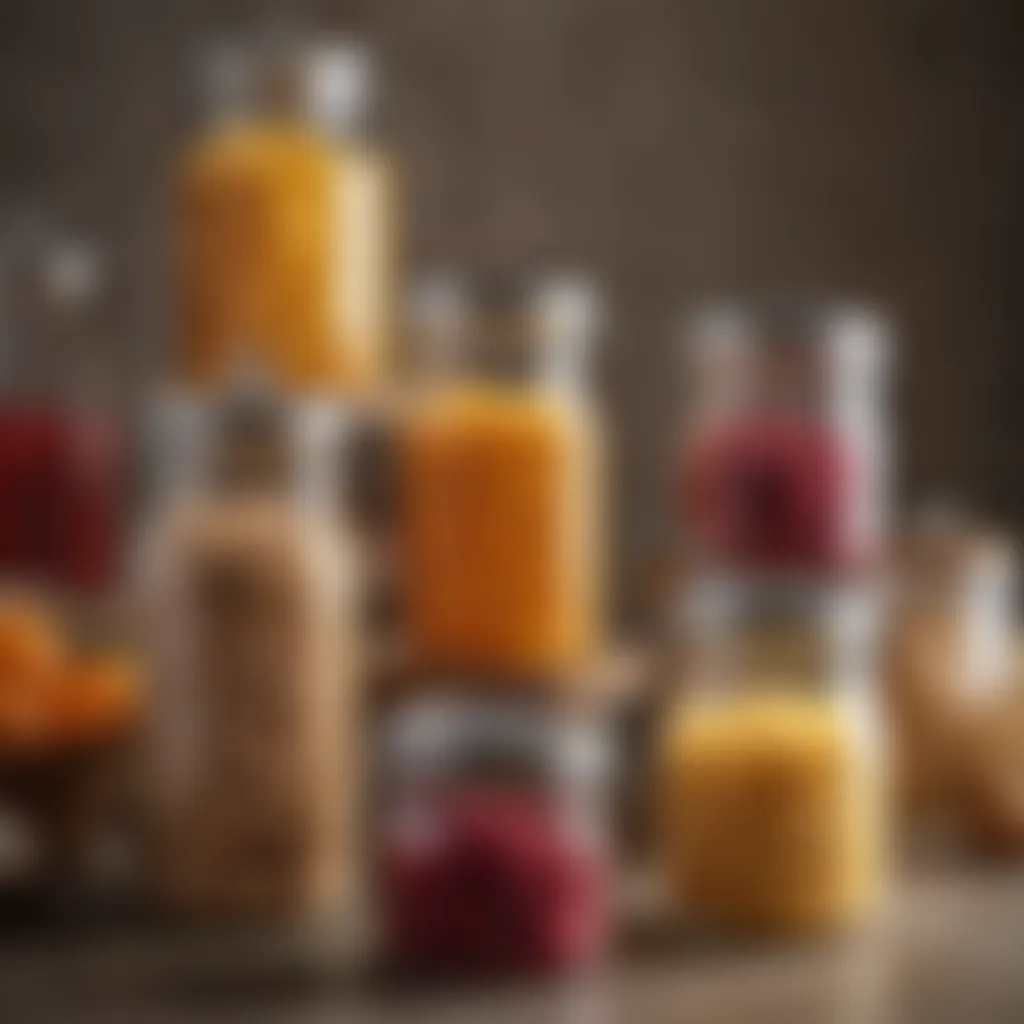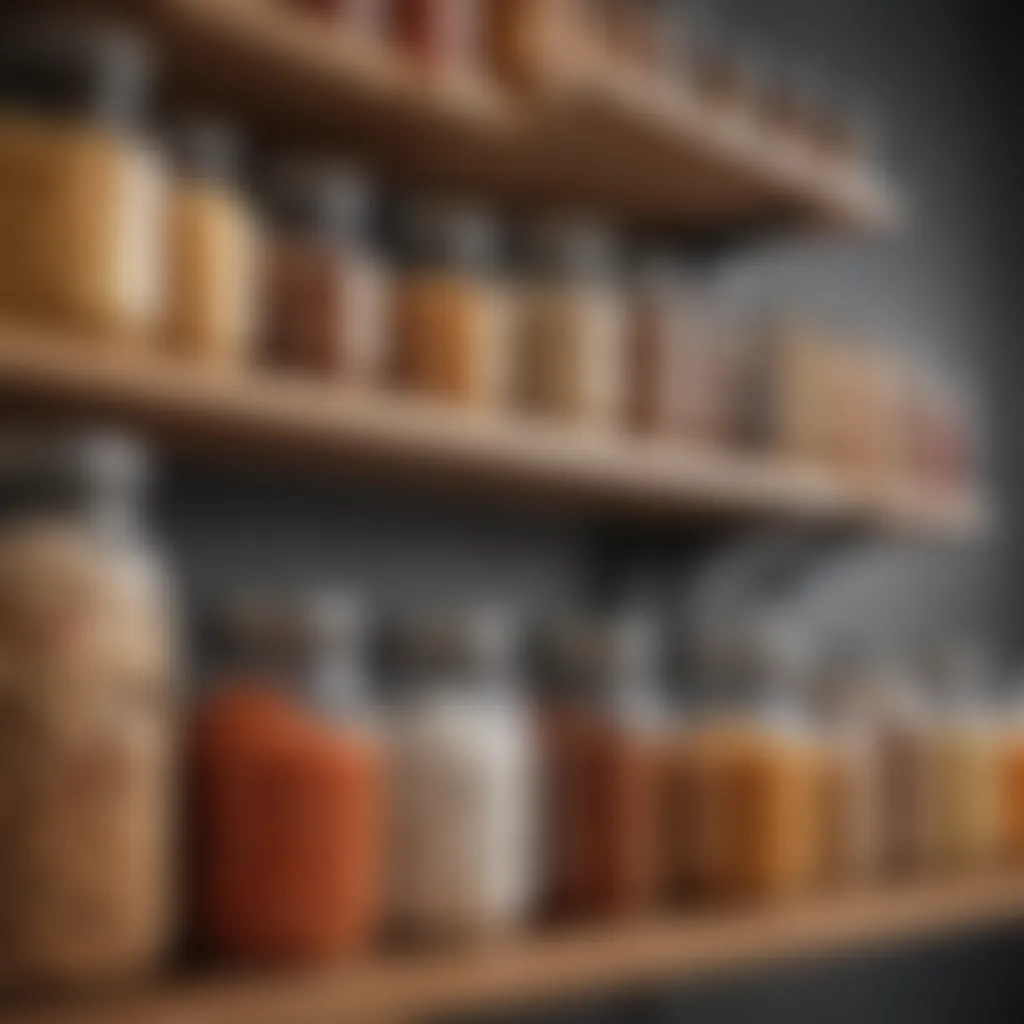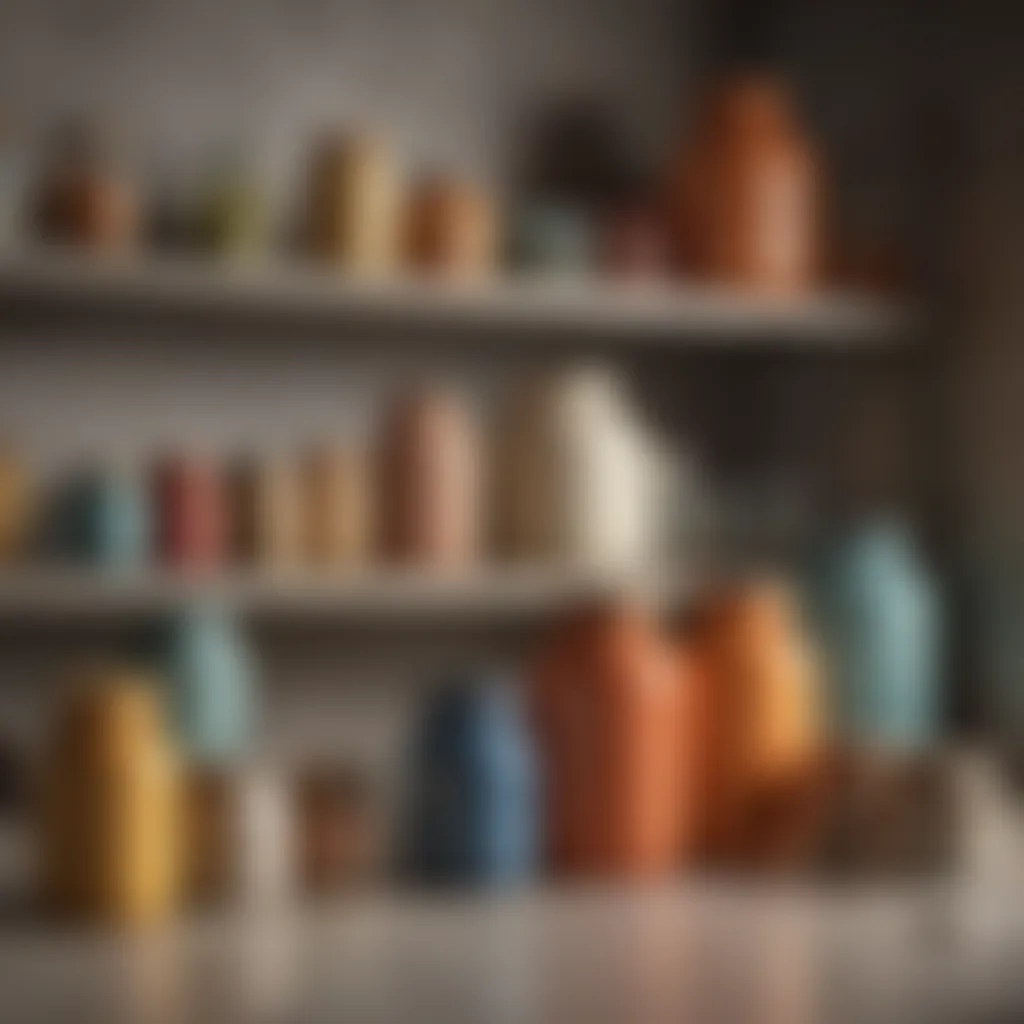Maximize Pantry Space with Storage Jars


Intro
A well-organized pantry is the backbone of any functional kitchen. Storage jars play a significant role in achieving this order. They come in various shapes, sizes, and materials, making them essential for anyone looking to optimize their kitchen space. By understanding how to use these jars effectively, one can greatly enhance their cooking experience and simplify meal preparation.
In this discussion, we will explore the myriad benefits of using storage jars. We will address why they are important for categorizing ingredients, maintaining freshness, and creating an aesthetically pleasing environment. Additionally, this guide will provide practical tips on materials, sizing, and overall functionality for each type of jar available in the market.
Let’s dive into the essential details surrounding the organization and purpose of pantry storage jars.
Prelims to Pantry Storage
The organization of a pantry is fundamental not only for aesthetic appeal but also for practicality. A well-organized pantry enables one to locate ingredients swiftly, reducing the time spent preparing meals. It is essential to understand that proper storage jars play a pivotal role in achieving this functionality. They help maintain food quality, optimize space, and enhance accessibility, making your pantry a more efficient workspace.
In essence, the right storage solutions can transform a cluttered space into a systematically arranged area. This article will examine the diverse types of storage jars, their benefits, and considerations for effective pantry organization. With this knowledge, both the novice and seasoned home cook can elevate their kitchen experience.
The Importance of Organization
Organization in the pantry allows for a seamless cooking process. When ingredients are clearly visible and easily reachable, meal preparation becomes less daunting. An organized pantry reduces waste, as food is less likely to expire without notice. Storage jars serve this purpose by providing a clear view of contents, thus helping manage inventory more effectively. They help separate different food items and minimize confusion over what is available. When cooking is efficient, it not only saves time but also enhances the joy of creating meals.
Overview of Storage Solutions
Diverse storage solutions are available, catering to various needs and preferences. Key types include glass, plastic, metal, and ceramic storage jars. Each material offers unique benefits and downsides, which have implications for food storage.
- Glass storage jars are often favored for their aesthetic properties and ability to keep foods fresh without absorbing odors.
- Plastic jars are lightweight and typically less fragile, making them a practical choice for families with children.
- Metal jars provide durability and are ideal for long-term storage, especially in areas exposed to moisture.
- Ceramic jars, while stylish, come with a consideration of weight and breakability but can add a charming element to pantry décor.
Each type of storage solution has its place in a well-structured pantry. The choice ultimately depends on your specific needs, preferences, and how each jar's properties align with your cooking habits.
Types of Storage Jars
Understanding the various types of storage jars is essential for effective pantry organization. Each type offers unique features that cater to different needs, from material durability to visibility of the contents. This variety ensures that there is a suitable option for every pantry setup, allowing for better food preservation and aesthetic appeal in kitchen spaces. In the following sections, we will delve into the characteristics and benefits of glass, plastic, metal, and ceramic storage jars, guiding the way toward optimal pantry functionality.
Glass Storage Jars
Benefits of Glass
Glass storage jars provide a non-reactive environment for food storage. This means that the contents are less likely to absorb flavors or odors, maintaining the integrity of dry goods or liquids. One key characteristic of glass jars is their visibility, which allows easy identification of contents without the need for opening each jar. They are highly regarded for being more environmentally friendly, as glass is recyclable and typically free from harmful chemicals like BPA.
However, glass can break, which can be a drawback for households with children or in high-traffic kitchen areas. Overall, glass storage jars are a popular choice due to their combination of practicality and aesthetic appeal.
Common Sizes and Shapes
Glass jars come in a variety of sizes and shapes. Common shapes include tall, wide-mouth, and round jars, which cater to different types of food storage needs. For example, tall jars are advantageous for storing pasta, while wide-mouth jars work well for snacks or bulk items.
The availability of various sizes allows for optimal space utilization in the pantry. The biggest advantage is that these jars can often be paired with a matching set, contributing to a cohesive appearance in the kitchen. However, larger jars may occupy more space, necessitating a balance between size and storage capacity.
Plastic Storage Jars
Advantages of Plastic
Plastic storage jars are lighter and often more affordable than glass. They are typically durable and resistant to breaks, making them suitable for busy kitchens or households with children. One of the most attractive features of plastic jars is their versatility in size and heavy-duty use. They often come with airtight lids that help preserve freshness by minimizing moisture and air exposure.
Despite their advantages, plastic jars can sometimes retain odors from contents, which may influence flavors when reused. Nonetheless, they remain a beneficial option for many pantry setups due to their practicality and convenience.


Considerations for Use
When choosing plastic storage jars, it is essential to consider the types of food being stored. Some plastic materials may not withstand heat and washing in dishwashers. It's also important to select BPA-free containers to avoid potential health risks. These considerations ensure that plastic jars remain safe and effective for food storage. While plastic jars can provide significant advantages, understanding their limitations is crucial for optimal use in pantry organization.
Metal Storage Jars
Durability and Functionality
Metal storage jars are known for their strength and longevity. They can withstand a lot more wear and tear than glass or plastic. One key aspect is that metal jars are often airtight, protecting contents from moisture and pests. Additionally, they can be stacked, saving space within the pantry.
However, some metal jars may react with acidic foods, which can limit their use for certain items. Overall, metal storage jars stand out for their robust functionality but require caution regarding the types of contents being stored.
Best Uses for Metal Jars
Metal jars are particularly suited for dry goods such as flour, sugar, and other bulk ingredients. They can also be used for items that require long-term storage, like spices. Their design often appeals to consumers seeking an industrial or modern aesthetic in their kitchen. However, their heavier weight compared to plastic might be a consideration, especially for frequently accessed items.
Ceramic Storage Jars
Pros and Cons of Ceramic
Ceramic storage jars offer a unique option with benefits such as an appealing visual design. They can enhance kitchen decor and are available in various colors and patterns. One strong point is their ability to resist moisture and maintain a stable temperature for food preservation. However, they can be fragile and prone to cracking if dropped. This makes them less suitable for households with children.
That said, ceramic jars can be perfect for decorative or less frequently accessed items, blending functionality with aesthetic appeal.
Design and Aesthetic Considerations
The design of ceramic jars is often more varied than other materials. They can add a decorative element to pantry organization, with many styles that can match different kitchen themes. The opportunity to choose from various colors and patterns is a distinct advantage. However, the heavier weight may complicate stacking and storage efficiency compared to lighter alternatives. In an organized pantry, the use of ceramic jars enhances the space's overall visual harmony while serving practical purposes.
Benefits of Using Storage Jars in the Pantry
Storage jars play a critical role in enhancing pantry organization. Their utility extends beyond mere containment; they serve as tools for optimizing space, preserving food freshness, and improving visibility. Effective storage solutions can simplify meal preparation while contributing to a more visually appealing kitchen environment.
Space Optimization
Maximizing space is a key factor in pantry management. Storage jars allow for the efficient use of vertical space, especially in smaller kitchens. By stacking jars or placing them on shelves, you declutter countertops and create a more open area for culinary activities.
Consider utilizing various jar sizes; larger jars can hold bulk items while smaller ones manage spices or snacks. Grouping similar products together inside jars also encourages an organized look, preventing wastage of space. You can achieve a uniform style by using jars of the same shape or color, which creates a visually pleasing display that enhances your pantry's overall aesthetic.
Preservation of Food Quality
Food longevity is another significant advantage of using storage jars. Many pantry staples, such as grains, nuts, or dried fruits, benefit from being in airtight containers. This helps to prevent moisture and pests from affecting the quality of food. Plastic, glass, ceramic, and metal jars offer varying levels of protection, but secure sealing is essential for all.
Using these jars can preserve freshness and flavor. For example, a tightly sealed glass jar can keep coffee beans fragrant far longer than a paper bag. This subsequently leads to reduced food waste, as items remain good for an extended period.
Enhanced Visibility and Accessibility
Visibility is crucial in a well-organized pantry. Clear or labeled storage jars enable easy identification of contents. This minimizes the time spent searching for ingredients, which can otherwise disrupt meal preparation. Not only does this promote efficiency, but it also encourages you to utilize older items before they expire, ultimately promoting a zero-waste approach.
Labels can further enhance accessibility. Writing the contents or the expiration date on each jar provides instant recognition. Whether using chalkboard labels or simple masking tape, any system that allows for easy reading can simplify the cooking process.
"Effective organization is not just about storage; it fosters a more efficient cooking environment."


Choosing the Right Storage Jar
Choosing the right storage jar is crucial for an organized and functional pantry. The type of jar can impact not just the appearance of your pantry but also the preservation of your food items. When you select the right storage jar, you maximize efficiency. This allows you easy access to your ingredients as you prepare meals. Moreover, a thoughtful choice can enhance the overall aesthetic, making cooking a more enjoyable experience.
Assessing Pantry Needs
Before you begin selecting storage jars, you should assess your specific pantry needs. Think about the types of ingredients you commonly store. Are they dry goods, snacks, or bulk items? Consider how often you use these items. If you frequently reach for certain ingredients, choose jars that are easy to access. Also, take note of the available space in your pantry. Understanding your needs helps you make informed decisions about jar types and sizes that fit within your environment.
Evaluating Material and Design
Material and design are important factors when choosing storage jars. Glass jars offer durability and the ability to see contents without opening the jar. They are ideal for storing items like spices or grains, where visibility aids in quick identification. Plastic jars can be lightweight and shatterproof, making them great for households with children. When choosing a jar, consider the design as well. A well-designed jar can serve as decor while being functional. A matching set can bring cohesiveness to your pantry.
Sizing Considerations
Sizing is another critical aspect of selecting storage jars. A range of sizes allows for better organization. Smaller jars are perfect for herbs and spices, while larger jars can accommodate bulk items like flour or sugar. Evaluate your pantry layout and determine how much space each jar will occupy. Utilizing a mix of sizes can enhance both storage capacity and functionality. Make sure to measure the pantry shelves before purchasing to ensure jars will fit comfortably.
"Selecting the appropriate storage jars is not merely about aesthetics; it is about enhancing the functionality of your cooking space."
By thoughtfully assessing your pantry needs, evaluating material and design, along with considering sizing, you can effectively choose the right storage jars that will enhance your kitchen’s efficiency.
Maintenance and Care of Storage Jars
The longevity and efficiency of storage jars in your pantry depends heavily on proper maintenance and care. Regular upkeep not only extends their life but also ensures that they continue to serve their primary function—keeping your ingredients safe and fresh. Neglect can lead to issues such as contamination or reduced lifespan, making it crucial to understand the right practices for maintenance.
Cleaning Guidelines
Keeping storage jars clean is essential for food safety and hygiene. The cleaning process can vary depending on the material of the jar:
- Glass Jars: Wash them using warm soapy water. Avoid using abrasive sponges, as they can scratch the glass. If food residue is stuck, a mixture of vinegar and water can help break it down.
- Plastic Jars: These often require gentler handling. Use mild soaps and avoid harsh chemicals. They can absorb odors, so consider using baking soda for deeper cleaning.
- Metal Jars: For stainless steel or aluminum jars, use gentle detergent and cloth. They should not be soaked for long periods to avoid rusting.
- Ceramic Jars: These can usually go in the dishwasher, but check for any glaze that might be sensitive to high temperatures. Hand washing is safest if unsure.
Cleaning should be done regularly, especially if you switch contents frequently. Ensure the jars are completely dry before refilling them to prevent dampness that can lead to mold.
Avoiding Damage
Proper handling can prevent damage to storage jars. Here are some key considerations:
- Avoid Extreme Temperatures: Do not expose glass jars to rapid temperature changes. For example, do not move a hot jar directly to a cold surface. This can cause cracking.
- Gentle Placement: When placing jars on shelves or counters, do so gently. A sudden impact can lead to chips or cracks, especially in glass and ceramic jars.
- Storage Position: If stacking jars, ensure they are designed for that use. Not all jars can safely be stacked, and doing so might lead to breakage.
- Monitor for Scratches: Regularly check plastic jars for scratches which can harbor bacteria and compromise their integrity. Replace any that seem excessively worn.
Following these guidelines will help you maintain the appearance and functionality of your storage jars, ensuring they remain a vital part of your pantry for many years.
"Well-maintained storage jars not only enhance the aesthetics of your pantry but also ensure food stays fresh and safe."
With the right care, storage jars can be a reliable ally in your kitchen organization efforts.
Aesthetic Considerations in Pantry Organization
A well-designed pantry does more than store food; it can become a visual centerpiece in your kitchen. Aesthetic considerations in pantry organization play a significant role in enhancing not just the functionality but also the overall appeal of the space. The visual arrangement can contribute to an efficient workflow, making the cooking experience more enjoyable.
When organizing your pantry, it's essential to balance aesthetics with practical needs. This balance involves selecting the right storage jars, which can vary in terms of material, color, and shape. A cohesive look can create a sense of order, which may also influence your cooking habits positively. A cluttered pantry can lead to stress, while a well-organized one encourages a more methodical approach to meal preparation.
Choosing a Color Scheme


Color schemes play a vital role in creating the aesthetics of a pantry. The right colors can foster creativity and calmness. When selecting storage jars, consider colors that complement your kitchen layout. For example, if your kitchen has warm wood tones, jars in earth tones, such as greens and browns, may enhance the environment. Choosing a monochromatic scheme with different shades of one color can also create a modern look but should still accommodate function.
Often, using transparent jars allows the natural colors of food items to shine through, providing a more vibrant look. If you prefer a more playful design, colorful lids or decorative jars can add personality without compromising organization.
Labeling Storage Jars
Labeling is not merely a practical necessity; it also adds a layer of design continuity to jars. Clear labels help in quickly identifying contents, aiding in the cooking process. You can choose from various styles, fonts, and even colors that match your overall pantry theme. Consider using a label maker for a uniform look. Alternatively, handwritten labels can add a personal touch, making the pantry feel warm and inviting.
When placing the labels, ensure they are visible but not intrusive. Consistency in label style will also enhance the aesthetic aspect, contributing to the organized look of your pantry. Overall, thoughtful labeling and color selection can elevate both functionality and beauty in your pantry organization.
Innovative Uses for Storage Jars
Storage jars are not only practical for organization in the pantry but also facilitate innovative methods for storage and display. These jars can transform a kitchen space, making it not just functional but also visually appealing. By utilizing their versatility, households can maximize space and enhance their culinary environment.
Understanding innovative uses is crucial in today’s cooking and planning. One can repurpose jars for various applications throughout the kitchen. This opens up possibilities beyond mere storage of dry goods. For example, jars can be repurposed for bulk ingredient storage, which allows for purchasing in larger quantities, saving money, and reducing waste.
Moreover, the aesthetic potential of jars should not be overlooked. They can be styled in various forms to complement the kitchen decor. Incorporating decorative elements with storage can make the pantry not only organized but also a focal point in the kitchen, elevating the experience and practicality at the same time.
"Storage jars can go beyond functionality; they can redefine how we experience our food and workspace."
Additionally, their clear design allows you to quickly identify contents, creating a more efficient meal prep process. With a bit of organization, using jars creatively can facilitate everyday cooking tasks.
Using Jars for Bulk Ingredients
Using storage jars for bulk ingredients is an exemplary strategy for minimizing cost and maximizing freshness. Bulk shopping can significantly lower expenses, as items like rice, legumes, and flours are often cheaper when bought in larger quantities.
When storing these bulk items, select jars with airtight seals, which prevent moisture and pests from ruining food quality. Glass jars like those from Ball or Mason brand are ideal as they are sturdy and offer good visibility. Make sure to label jars accurately. This practice enhances both organization and accessibility.
Consider the following practical tips when using jars for bulk ingredients:
- Choose Appropriate Sizes: Select jars that match your storage needs. Large jars are perfect for staples, while smaller jars can manage spices or specialty ingredients.
- Maintain Cleanliness: Ensure that jars are thoroughly cleaned and dry before filling them. This will keep the contents fresh for extended periods.
- Rotation: Always use the FIFO method (First In, First Out) when using stored ingredients to avoid waste.
Creative Pantry Solutions
Creativity in pantry organization can lead to significant enhancements in function and style. Beyond essentials, storage jars can be adapted for unique uses that suit individual needs. For instance, consider combining multiple jars in various sizes and shapes to create a visually appealing display.
You can also utilize jars to manage cooking supplies like nuts, seeds, and dried fruits. This arrangement not only looks good but also increases your cooking efficiency by having ingredients readily available. Incorporating jars on tiered shelves, or using a wall-mounted shelving system can further add to the solution.
Other innovative options include repurposing jars for non-food items. For example:
- Craft Supplies: Use jars to store buttons, beads, or paintbrushes. This method keeps materials organized and visible.
- Bathroom Storage: Glass jars can also store cotton balls, hair ties, or makeup brushes, enhancing organization while adding aesthetic appeal.
- Office Storage: Keep office supplies like paper clips and pens neat and tidy in decorative jars.
Final Thoughts on Pantry Storage Solutions
Emphasizing Functionality and Style
Storage jars serve as more than mere containers; they are essential tools for kitchen optimization. First, functionality stands at the forefront. Each jar, regardless of its material, should cater to the specific needs of its contents. Choosing the right size ensures that larger staples can be stored alongside smaller items efficiently. For example, glass jars are commonly chosen for pasta or grains, while smaller jars may suit herbs or spices. This strategic selection not only saves space but also maximizes the pantry’s accessibility.
Alongside functionality, the style aspect cannot be overlooked. The visual appeal of storage jars can significantly impact the overall kitchen ambiance. Coordinating colors and designs create a sense of harmony. For instance, using matching glass jars can impart a modern touch, while ceramic jars may offer a rustic charm. Thus, thoughtful selection enhances both practical use and the kitchen's overall decor.
"A well-organized pantry reflects a well-organized mind."
Building a Sustainable Pantry
Addressing sustainability is integral when considering pantry storage options. In this modern age, eco-conscious choices have gained momentum. Opting for storage jars made from sustainable materials, like recycled glass or BPA-free plastic, minimizes environmental impact. Furthermore, reusing existing jars, perhaps from previous purchases, promotes a zero-waste lifestyle, which is highly beneficial.
When creating a sustainable pantry, it is also important to consider purchasing in bulk. Using larger jars for bulk items reduces packaging waste and future trips to the store. This practice not only benefits sustainability but also can lead to cost savings over time.
Ultimately, a functional pantry reflects an organized lifestyle that values sustainability. By emphasizing both proper storage techniques and eco-friendly practices, individuals can create a pantry that is both efficient and mindful. Navigating through these considerations ensures that the solution not only serves present needs but is also adaptable for future culinary adventures.







